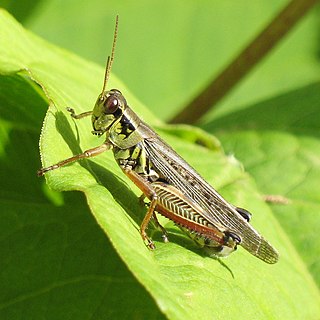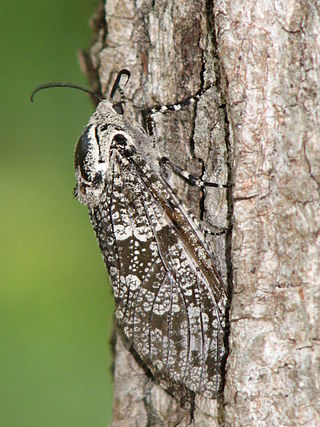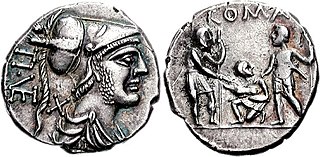Foederati were peoples and cities bound by a treaty, known as foedus, with Rome. During the Roman Republic, the term identified the socii, but during the Roman Empire, it was used to describe foreign states, client kingdoms or barbarian tribes to which the empire provided benefits in exchange for military assistance. The term was also used, especially under the empire, for groups of "barbarian" mercenaries of various sizes who were typically allowed to settle within the empire.
Lucius Furius Philus was a Roman statesman who became consul of ancient Rome in 136 BC. He was a member of the Scipionic Circle, and particularly close to Scipio Aemilianus.

The Latin League was an ancient confederation of about 30 villages and tribes in the region of Latium near the ancient city of Rome, organized for mutual defense. The term "Latin League" is one coined by modern historians with no precise Latin equivalent.

In Ancient Rome, the Latin term civitas, according to Cicero in the time of the late Roman Republic, was the social body of the cives, or citizens, united by law. It is the law that binds them together, giving them responsibilities on the one hand and rights of citizenship on the other. The agreement has a life of its own, creating a res publica or "public entity", into which individuals are born or accepted, and from which they die or are ejected. The civitas is not just the collective body of all the citizens, it is the contract binding them all together, because each of them is a civis.
Bassano Romano is a town and comune situated in the hills of Monti Sabatini in the province of Viterbo, in northern Lazio (Italy). With its origins about 1000 as the agricultural hamlet of Bassano di Sutri the village's future was founded in 1160 by the wealthy landowner Enotrio Serco, who initiated the construction at the top of the slope of a fortified residence that over the centuries became a princely dwelling, frescoed by famous artists. In 1482 Pope Sixtus IV assigned the Foedus Bassani to the Anguillara, Roman patricians . The growth of the comune redoubled after 1565, when the signory was reassigned by Pope Clement VIII to the Giustiniani, merchants of Genoese origin settled at Rome. In 1605 the signory was raised to a marquessate: a hunting lodge called "La Rocca", granaries, a stone bridge and the church dedicated to San Vincenzo were all constructed. During the Giustiniani residence, artists were commissioned to carry out frescoes: Francesco Albani, Domenico Zampieri "Domenichino" and Antonio Tempesta are all represented. In 1644, a bulla of Pope Innocent X made the marchese of Bassano a prince, and the flock of papal and noble visitors included James Stuart, pretender to the thrones of England and Scotland. In 1735, under Giustiniani patronage the maiolica manufactory of Bartolomeo Terchi was transferred here from Siena.

Melanoplus is a large genus of grasshoppers. They are the typical large grasshoppers in North America. A common name is spur-throat grasshoppers, but this more typically refers to members of the related subfamily Catantopinae.

The Cossinae are the nominate subfamily of the Cossidae. The caterpillars of several Cossinae species, such as the carpenterworm and the goat moth, are significant pests. On the other hand, in Chile the caterpillars of the Chilean moth are collected on a commercial scale for sale as fishing bait and terrarium pet food; they are usually called "butterworms" in international trade.
According to Roman tradition, the Foedus Cassianum or the Treaty of Cassius was a treaty which formed an alliance between the Roman Republic and the Latin League in 493 BC after the Battle of Lake Regillus. It ended the war between the Latin League and Rome, placing Rome as equal in power to all of the members of the League combined.

Chonetes is an extinct genus of brachiopods. It ranged from the Late Ordovician to the Middle Jurassic.

The gens Veturia, originally Vetusia, was an ancient patrician family of the Roman Republic. According to tradition, the armourer Mamurius Veturius lived in the time of Numa Pompilius, and made the sacred ancilia. The Veturii occur regularly in the Fasti Consulares of the early Republic, with Gaius Veturius Geminus Cicurinus holding the consulship in 499 BC. Like other old patrician gentes, the Veturii also developed plebeian branches. The family declined in the later Republic, with the last consular Veturius holding office in 206 BC, during the Second Punic War.
Austrobatrachus foedus, the puzzled toadfish, is a species of toadfish found along the Atlantic Coast of South Africa. This species grows to a length of 27 cm (11 in).
Austrobatrachus is a genus of toadfishes found in the Atlantic and Indian Oceans off the coast of South Africa.
Ariaric also known as Ariacus was a 4th-century Thervingian Gothic pagan ruler He was succeeded by Geberic. In 328, Constantine the Great constructed a bridge across the Danube and built fortifications in the territory of Oltenia and Wallachia. This caused a migration of the Thervingi and Taifali to the west into Tisza Sarmatian controlled areas. The Sarmatians joined forces with Constantine, who appointed his son Constantine II to campaign against the Goths in late winter 332, reportedly resulting in the deaths of approximately one hundred thousand people due to the weather and lack of food. Ariaric was forced to sign a treaty or foedus with Constantine in 332. Yet some scholars dispute that this treaty was a foedus, but more like an act of submission.
Eremocossus is a genus of moths in the family Cossidae first described by George Hampson in 1893.
Eremocossus nubica is a moth in the family Cossidae. It was described by Yakovlev in 2008. It is found in Sudan.
Eremocossus almeriana is a moth in the family Cossidae. It was described by Josef J. de Freina and Thomas Joseph Witt in 1990. It is found in south-eastern Spain.

Rallicola is a genus of chewing louse. It is an ectoparasite of rails and other birds. It was named by Thomas Harvey Johnston and Launcelot Harrison in 1911. There are two subgenera aside from the nominotypical subgenus: Aptericola, whose species are found on kiwi birds, and Huiacola, a monospecific subgenus consisting of Rallicola extinctus, once found on the huia.

Melanoplus foedus, the striped sand grasshopper, is a species of spur-throated grasshopper in the family Acrididae. It is found in North America.








